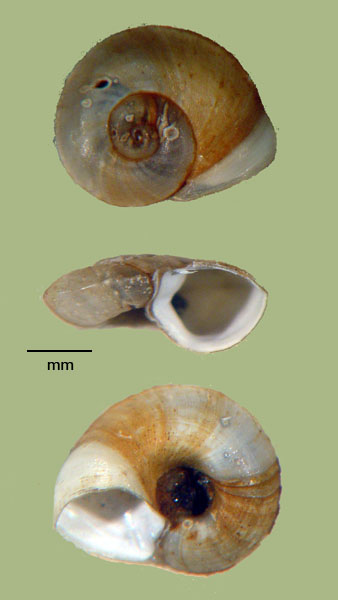> Habitat & Distribution
This is another of the less-commonly encountered planorbids of the Eastern United States, sparsely distributed in widely-scattered ponds and sluggish streams of the Atlantic Coastal Plain and Interior Plateaus. Populations of P. exacuous become more common and widespread in northern latitudes, ranging through Canada south through the Rockies, especially in quiet, shallow areas of lakes and rivers, as well as intermittent ponds (Baker 1928, Clarke 1981, Jokinen 1992, Jokinen 2005). They are common in the glaciated eastern halves of The Dakotas. FWGNA incidence rank I-4.
> Ecology & Life History
Promenetus exacuous populations are typically associated with plant matter of autochthonous or allocthonous origins, rarely occurring in the absence of these resources (Clarke 1981, Harman 1982, Jokinen 1983, 1992, 2005). Individuals are typically found on mud or vegetation. Water quality ranges from soft to hard (Jokinen 1983, McKillop 1985, Dillon 2000). Even in favorable situations, P. exacuous is rarely found in great abundance (McKillop 1985, Pip 1985, Pip 1991).
Although P. exacuous occurs in eutrophic systems, it may be sensitive to environmental degradation (Clarke 1979). Abundance and frequency of occurrence declined precipitously in southern Manitoba between 1978 and 1998 as intensive agriculture and other human land-use impacts increased (Pip 2000). Promentus exacuous also seems to have been extirpated from Oneida Lake, NY, between 1968 and 1992, perhaps as a consequence of hypereutrophication (Harman 2000).
Jokinen s (1987) analysis of the distribution of P. exacuous in Connecticut and New York led her to classify it as a C-D tramp, potentially present in nearly every community. Dillon s (2000: 360-363) reanalysis of these data suggested that P. exacuous populations in the region seem to be Undifferentiated with respect to life history adaptation.
The few life history studies focusing on this species suggest that P. exacuous is semelparous, with two cohorts produced each year (McKillop 1985, Jokinen 1992). This is life cycle C of Dillon (2000:158).
> Taxonomy & Systematics
The classification of the Planorbidae proposed by the tag team of Baker (1945) and Hubendick (1955) remains, after 50 years, the basis for our understanding of this large and diverse family of pulmonates worldwide. See the essay of 11Apr08 below. Say originally assigned his species to the genus Planorbis. Baker (1928) split exacuous first to his genus Menetus, then to his Promenetus. The spelling "exacutus" is a synonym (Stewart and Dillon 2004, Stewart 2006).
> Maps and Supplementary Resources
- Promenetus distribution in Atlantic drainages (2023)
- Promenetus in Georgia and the Florida panhandle (2025)
- Promenetus distribution in The Great Plains (2024)
> Essays
- Promenetus was featured in my post to the FWGNA blog of 17Nov05, Aerial Dispersal of Freshwater Gastropods.
- See my post to the FWGNA blog of 11Apr08 for a review of the Classification of the Planorbidae.
- Or view the (Hubendick 1955) classification of North American planorbids in a tabular format [here].
> References
Baker, F. (1928) Freshwater Mollusca of Wisconsin, Part I, Gastropoda. Bull. Wisc. Geol. Natur. Hist. Survey, no. 70. University of Wisconsin Press, Madison.
Baker, F. (1945) The Molluscan Family Planorbidae. Urbana: University of Illinois Press.
Baker, H. B. (1946) Index to F.C. Baker's "The Molluscan Family Planorbidae." Nautilus, 59, 127-41.
Burch, J.B. (1989) North American Freshwater Snails. Malacological Publications, Hamburg, Michigan.
Clarke, A.H. (1979) Gastropods as indicators of trophic lake stages. Nautilus 93:138-142.
Clarke, A.H. (1981) The Freshwater Molluscs of Canada. National Museum of Natural Sciences, National Museums of Canada, Ottawa, Canada.
Dillon, R.T., Jr. (2000) The Ecology of Freshwater Molluscs. Cambridge University Press, Cambridge, United Kingdom.
Harman, W.N. (1982) Benthic substrates: their effect on fresh-water Mollusca. Ecology 53: 271-277.
Harman, W.N. (2000) Diminishing species richness of mollusks in Oneida Lake, New York State, USA. The Nautilus 114:120-126.
Hubendick, B. (1955) Phylogeny in the Planorbidae. Trans. Zool. Soc. London 28: 453-542.
Jokinen, E.H. (1983) The Freshwater Snails of Connecticut. State Geological and Natural History Survey of Connecticut, Department of Environmental Protection Bulletin 109, Hartford, Connecticut.
Jokinen, E.H. (1987) Structure of freshwater snail communities: species-area relationships and incidence categories. American Malacological Bulletin 5:9-19.
Jokinen, E.H. (1992) The Freshwater Snails (Mollusca: Gastropoda) of New York State. New York State Museum Bulletin 482, Albany, New York.
Jokinen, E.H. (2005) Pond molluscs of Indiana Dunes National Lakeshore: then and now. American Malacological Bulletin 20:1-9.
McKillop, W.B. (1985) Distribution of aquatic gastropods across the Ordovician dolomite Precambrian granite contact in southeastern Manitoba, Canada. Canadian Journal of Zoology 63:278-288.
Pip, E. (1985) The ecology of freshwater gastropods on the southwestern edge of the Precambrian Shield. The Canadian Field-Naturalist 99: 76-85.
Pip, E. (1991) Macrophyte and associated mollusc communities in a Meteor Crater Lake on the Precambrian Shield of Manitoba. The Canadian Field-Naturalist 105: 483-487.
Pip, E. (2000) The decline of freshwater molluscs in southern Manitoba. The Canadian-Field Naturalist 114:555-560.
Pip, E., and W. F. Paulishyn (1971) The ecology and distribution of Promenetus exacuous Say in southern Manitoba. Can. J. Zool. 49: 367-372.
Richards, H. G. (1934) A list of the mollusks of the District of Columbia and vicinity. Amer. Midl. Natur. 15: 85-88.
Stewart, T.W., and R.T. Dillon, Jr. (2004) Species composition and geographic distribution of Virginia s freshwater gastropod fauna: a review using historical records. American Malacological Bulletin 19:79-91.
Stewart, T.W. (2006) The freshwater gastropods of Iowa (1821-1998): species composition, geographic distributions, and conservation concerns. American Malacological Bulletin 21: 59 - 75.








